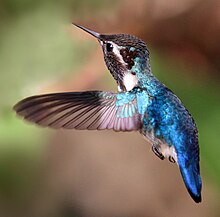

Size is an important aspect of dinosaur paleontology, of interest to both the general public and professional scientists. Dinosaurs show some of the most extreme variations in size of any land animal group, ranging from tiny hummingbirds, which can weigh as little as two grams, to the extinct titanosaurs, such as Argentinosaurus and Bruhathkayosaurus[1] which could weigh as much as 50–130 t (55–143 short tons).
The latest evidence suggests that dinosaurs' average size varied through the Triassic, early Jurassic, late Jurassic and Cretaceous periods, and dinosaurs probably only became widespread during the early or mid Jurassic.[2] Predatory theropod dinosaurs, which occupied most terrestrial carnivore niches during the Mesozoic, most often fall into the 100–1,000 kg (220–2,200 lb) category when sorted by estimated weight into categories based on order of magnitude, whereas recent predatory carnivoran mammals peak in the range of 10–100 kg (22–220 lb).[3] The mode of Mesozoic dinosaur body masses is between one and ten metric tonnes.[4] This contrasts sharply with the size of Cenozoic mammals, estimated by the National Museum of Natural History as about 2 to 5 kg (4.4 to 11.0 lb).[5]
History of study
editEstimation methods
edit- Campione and Evans[6]
- Paul and Larramendi[7][1]
- Popularity of amateur research[8]
- Criteria for inclusion
Allometric methods
editVolumetric methods
editOther methods
editEvolutionary development over time
editSize diversity in early dinosaurs
editJurassic diversification and evolution of quadrupedality
edit- Quadrupedality evolved: sauropods (at least once), ornithopods (twice), thyreophorans (once or twice), ceratopsians (once or twice)
- Quadrupedality in ornithischians[9]
- Quadrupedal Spinosaurus and refutation
Emergence of gigantism
edit- Benson's research
Size decreases and the origin of birds
editDwarfism in non-avian dinosaurs
editCretaceous diversification
editBird size variation in the Cenozoic
editBody size study by group
editOrnithischia
editPublished estimates
edit- Ornithopods
- Marginocephalians
- Stegosaurs
- Ankylosaurs
Sauropodomorpha
editPublished estimates
edit- Downsizing Dreadnaughtus[10]
- Non-sauropod sauropodomorphs
- True sauropods
- Controversial or fragmentary taxa
Non-avian Theropoda
editPublished estimates
edit- Sources[11]
- All theropods
- Non-avian maniraptoriformes
- Smallest non-avian theropods
Avialae
editModern birds
editPublished estimates
edit- Birds
- Smallest birds
See also
editGallery
editTheropods
edit-
RSM P2523.8 (aka "Scotty"), generally considered to be the largest specimen of Tyrannosaurus
-
Several of the largest theropods
-
Size of various specimens of Spinosaurus
-
Size of various therizinosaurids
-
Size of Deinocheirus, the largest herbivorous theropod
-
Size of several alvarezsaurids, which were among the smallest dinosaurs
-
Large birds
-
Size of Pelagornis compared to other large birds
-
Several of the largest birds compared to large pterosaurs
-
Kelenken
-
Two of the largest Cenozoic birds
-
Bee hummingbird
-
Small halszkaraptorines
-
Utahraptor, the largest known paravian
-
Several dromaeosaurs, including two of the largest, Austroraptor and Utahraptor
-
large maniraptorans, including birds
-
Kairuku
-
Anthropornis and an emperor penguin
Sauropods
editOrnithischians
edit-
Size of both species of Triceratops
-
Fauna from the Hell Creek Formation, including several of the largest dinosaurs from several clades
-
Scelidosaurus, which may have been quadrupedal
-
Tenontosaurus, an early quadrupedal ornithopod
-
Iguanodon, an early member of hadrosauriformes which was primarily quadrupedal
-
Auroraceratops, a stem-ceratopsian which may have been quadrupedal
-
Koreanosaurus, a thescelosaurid which evolved quadrupedality without gigantism
References
edit- ^ a b Paul, Gregory S.; Larramendi, Asier (2023). "Body mass estimate of Bruhathkayosaurus and other fragmentary sauropod remains suggest the largest land animals were about as big as the greatest whales". Lethaia. 56 (2): 1–11. Bibcode:2023Letha..56..2.5P. doi:10.18261/let.56.2.5.
- ^ Sereno PC (1999). "The evolution of dinosaurs". Science. 284 (5423): 2137–2147. doi:10.1126/science.284.5423.2137. PMID 10381873.
- ^ Farlow JA (1993). "On the rareness of big, fierce animals: speculations about the body sizes, population densities, and geographic ranges of predatory mammals and large, carnivorous dinosaurs". In Dodson, Peter; Gingerich, Philip (eds.). Functional Morphology and Evolution. American Journal of Science, Special Volume. Vol. 293-A. pp. 167–199.
- ^ Peczkis, J. (1994). "Implications of body-mass estimates for dinosaurs". Journal of Vertebrate Paleontology. 14 (4): 520–33. doi:10.1080/02724634.1995.10011575.
- ^ "Anatomy and evolution". National Museum of Natural History. Archived from the original on 2007-11-11. Retrieved 2007-11-21.
- ^ Campione, Nicolás E.; Evans, David C. (2012). "A universal scaling relationship between body mass and proximal limb bone dimensions in quadrupedal terrestrial tetrapods". BMC Biology. 10: 60. doi:10.1186/1741-7007-10-60. PMC 3403949. PMID 22781121.
- ^ Paul, Gregory (2019). "Determining the Largest Known Land Animal: A Critical Comparison of Differing Methods for Restoring the Volume and Mass of Extinct Animals". Annals of Carnegie Museum. 85 (4): 335. doi:10.2992/007.085.0403.
- ^ Gayford, Joel H.; Engelman, Russell K.; Sternes, Phillip C.; Itano, Wayne M.; Bazzi, Mohamad; Collareta, Alberto; Salas-Gismondi, Rodolfo; Shimada, Kenshu (2024). "Cautionary tales on the use of proxies to estimate body size and form of extinct animals". Ecology and Evolution. 14 (9). Bibcode:2024EcoEv..1470218G. doi:10.1002/ece3.70218.
- ^ Dempsey, Matthew; Maidment, Susannah C. R.; Hedrick, Brandon P.; Bates, Karl T. (2023). "Convergent evolution of quadrupedality in ornithischian dinosaurs was achieved through disparate forelimb muscle mechanics". Proceedings of the Royal Society B: Biological Sciences. 290 (1992). doi:10.1098/rspb.2022.2435. PMC 9890092. PMID 36722082.
- ^ Bates, Karl T.; Falkingham, Peter L.; MacAulay, Sophie; Brassey, Charlotte; Maidment, Susannah C. R. (2015). "Downsizing a giant: Re-evaluating Dreadnoughtus body mass". Biology Letters. 11 (6). doi:10.1098/rsbl.2015.0215. PMC 4528471. PMID 26063751.
- ^ Therrien, François; Henderson, Donald M. (2007). "My theropod is bigger than yours … or not: Estimating body size from skull length in theropods". Journal of Vertebrate Paleontology. 27: 108. doi:10.1671/0272-4634(2007)27[108:MTIBTY]2.0.CO;2. ISSN 0272-4634.
